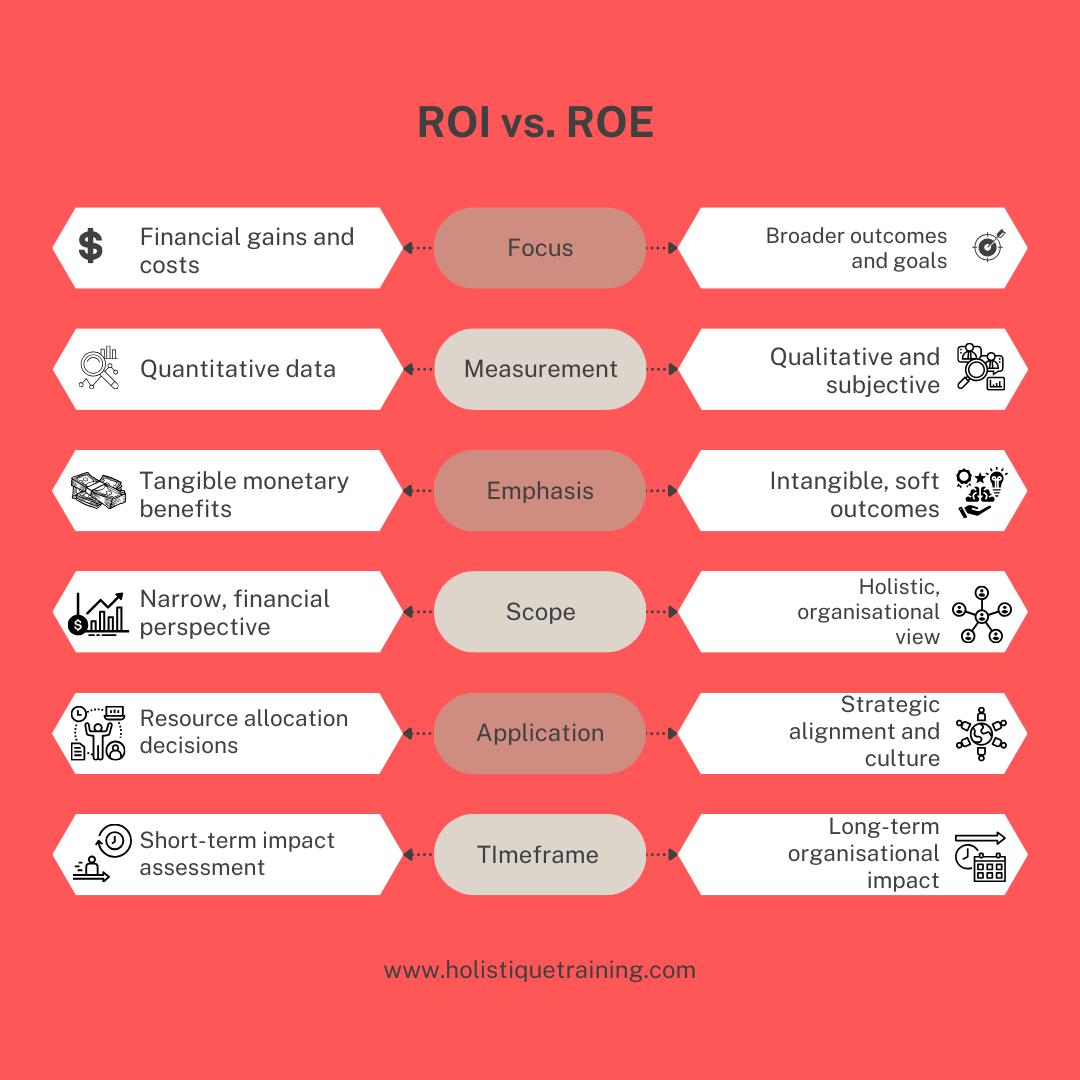Why Is Employee Training Important?
The Benefits of Measuring Training ROI
5 Ways to Measure Training ROI
Step-by-Step Process of Measuring Training ROI
ROI vs. ROE in Training and Development Programmes
What to Do with Measurement Results
Introduction
In the ever-evolving landscape of the modern workplace, the importance of employee training cannot be overstated. Companies invest significant resources in training and development programmes to enhance the skills and knowledge of their workforce. But how do you know if these investments are paying off? Enter the concept of Training Return on Investment (ROI), a vital metric that allows organisations to gauge the effectiveness of their training initiatives. In this comprehensive guide, we will delve into why employee training is crucial, what Training ROI entails, the benefits of measuring it, ways to measure it, a step-by-step process to calculate it, the distinction between ROI and ROE, tips to boost Training ROI, and what to do with the measurement results. So, let's begin our journey toward optimising training investments.
Why Is Employee Training Important?
Employee training serves as the lifeblood of an organisation, breathing vitality into its operations and future prospects. Unfortunately, though, some organisations still don’t realise that. In fact, almost 59% of employees report having received no formal workplace training, relying predominantly on self-teaching methods to acquire their skills, according to Lorman. That’s why it’s important to shed light on the importance of employee training and discuss its trove of benefits:
1. Skill Enhancement
Imagine a team of employees armed with outdated skills trying to navigate the complexities of today's fast-paced business landscape. It's akin to sending soldiers into battle without the latest weaponry. Employee training serves as the bridge between existing skills and the skills required to thrive in a rapidly evolving world. Through targeted training programmes, employees are equipped with the knowledge and expertise necessary to handle their responsibilities effectively. From mastering advanced software applications to honing soft skills like communication and leadership, training ensures that employees are not just adequate but exceptional in their roles.
2. Increased Productivity
Productivity is the lifeblood of any successful organisation. According to Zippia, when employee training is executed effectively, companies witness a 17% boost in productivity and a remarkable 218% increase in profit per employee. Whether it's streamlining manufacturing processes or optimising customer service interactions, trained employees are the driving force behind operational excellence.
3. Employee Engagement
Training isn't just about imparting knowledge; it's about investing in your employees' growth and development. When employees feel that their organisation is genuinely committed to enhancing their skills, a powerful sense of engagement ensues. Engaged employees are not just physically present at work; they are emotionally connected to their jobs and the organisation. This emotional investment translates into increased loyalty, reduced turnover rates, and a workforce that is more likely to go above and beyond to achieve organisational goals.
4. Innovation
Innovation is the lifeblood of progress. Trained employees are not confined by the boundaries of their job descriptions; they are empowered to think outside the box. A well-designed training programme nurtures creativity and encourages employees to explore new ideas, experiment with novel approaches, and contribute to the company's innovative endeavours. These creative sparks often lead to groundbreaking solutions, product enhancements, and process optimisations, giving the organisation a competitive edge in the market.
5. Adaptation to Change
The only constant in the business world is change. Technological advancements, market trends, and consumer preferences evolve rapidly. In such a dynamic environment, the ability to adapt swiftly and effectively is paramount. Training not only imparts new skills but also cultivates a mindset of adaptability. Employees trained to embrace change become valuable assets during times of transition. They navigate new technologies and business paradigms with confidence, ensuring that the organisation remains agile and responsive to market demands.
In essence, employee training is the cornerstone upon which a thriving, competitive, and resilient organisation is built. It's not merely an expense but an investment in the future – a future where employees are skilled, engaged, innovative, adaptable, and, most importantly, integral to the organisation's success story. By recognising the pivotal role of training in shaping a skilled workforce, companies pave the way for continuous growth and excellence, ensuring their relevance and prominence in the ever-evolving business landscape.
What Is Training ROI?
Training Return on Investment (ROI) is a quantitative measure that evaluates the financial benefits an organisation receives in return for the resources invested in employee training and development. It provides a clear picture of whether the training programmes are delivering tangible value and justifying the expenses incurred.
The Benefits of Measuring Training ROI
Measuring the Return on Investment (ROI) of training programmes is akin to shining a spotlight on the heart of an organisation's growth strategy. It's not merely a financial evaluation; it's a strategic compass that guides businesses toward the most effective ways to nurture their talent. Even though gauging training ROI provides a multitude of benefits, there are organisations out there who don’t fully realise its potential. In fact, according to a survey by Voxy, involving over 350 Human Resources professionals, merely 11% of organizations evaluate the ROI of their training initiatives. That being said, let's explore the manifold benefits of this crucial practice, illuminating why measuring Training ROI is pivotal in the modern workplace landscape:
Data-Driven Decision Making
In a world driven by data, measuring Training ROI provides organisations with tangible, numerical insights into the effectiveness of their training programmes. These insights are not just numbers; they are pieces of a puzzle that reveal which training initiatives yield the most significant impact. Armed with this information, decision-makers can make enlightened choices about where to allocate resources. Whether it's refining existing programmes or investing in new training modules, data-driven decisions ensure that every dollar spent contributes meaningfully to the organisation's objectives.
Resource Optimisation
Training programmes require substantial resources – time, money, and manpower. Measuring ROI ensures that these resources are not just spent but invested judiciously. By identifying which training initiatives provide the highest returns, organisations can optimise their resource allocation. This optimisation is not about cutting costs but about channelling investments where they generate the most value. It's a strategic reallocation that ensures training budgets are utilised effectively, maximising the impact on employee performance and, subsequently, organisational outcomes.
Performance Improvement
Measuring Training ROI goes beyond the realm of finance; it's about enhancing performance at its core. By evaluating the impact of training programmes, organisations can pinpoint areas where employees excel and where they struggle. This granular understanding allows for targeted enhancement. It might mean tweaking a module to focus on a specific skill, addressing a knowledge gap, or tailoring training content to better align with job requirements. The result? Employees who are not just trained but finely tuned to meet the organisation's unique needs, leading to improved overall performance.
Alignment with Business Goals
Every training initiative should be a stepping stone toward achieving broader business objectives. Measuring ROI ensures that these initiatives are not isolated efforts but strategic components of the organisation's roadmap to success. By quantifying the impact of training on key performance indicators, businesses can ensure that training programmes are intricately aligned with overarching goals. Whether the objective is to increase sales, enhance customer satisfaction, or improve product quality, Training ROI acts as a litmus test, validating whether these objectives are being met and, if not, guiding the necessary course corrections.
Demonstrated Value
Training programmes often require substantial financial investments, and securing ongoing support from stakeholders is essential. Measuring ROI provides concrete evidence of the value generated by these investments. It's not just about showcasing successes; it's about presenting a compelling business case. When stakeholders – be it executives, investors, or board members – see the clear correlation between training investments and tangible, positive outcomes, they are more inclined to offer continuous support. ROI data becomes the ammunition that strengthens the case for training, ensuring that it remains a priority in the organisation's strategic agenda.
5 Ways to Measure Training ROI
Measuring Training Return on Investment (ROI) isn’t a one-size-fits-all endeavour; it's a nuanced process that demands a thoughtful approach. Here, we explore five distinct methodologies, each offering unique insights into the effectiveness of training programmes. These methods not only quantify the financial gains but also provide a holistic view, encompassing qualitative improvements and long-term benefits.
1. Cost-Benefit Analysis
At the core of Training ROI lies the fundamental principle of weighing costs against benefits. A Cost-Benefit Analysis delves into the financial intricacies, encompassing the total expenditure on training, from development and delivery to administrative costs. This comprehensive approach accounts for both direct and indirect costs. On the benefits side, consider increased productivity, reduced errors, higher sales, or enhanced customer satisfaction. By meticulously comparing the costs and benefits, organisations gain a clear financial picture, enabling them to evaluate the profitability of their training endeavours.
2. Pre-Post Assessment
Knowledge is power, and training aims to enhance it. Pre-Post Assessment involves evaluating employees' skills and knowledge before and after training. This method provides a quantitative measure of the knowledge gained, making it particularly useful for technical training or skill-specific programmes. By comparing the pre-training baseline with post-training competence, organisations can calculate the increase in knowledge. This not only demonstrates the efficacy of the training but also highlights areas of improvement, ensuring a targeted approach to subsequent training initiatives.
3. Kirkpatrick's Four Levels of Evaluation
Kirkpatrick's Four Levels of Evaluation offers a holistic perspective, encompassing reaction, learning, behaviour, and results. The first level, reaction, gauges participants’ satisfaction and engagement. The second level, learning, assesses the knowledge and skills acquired during training. The third level, behaviour, evaluates changes in on-the-job behaviour resulting from the training. Finally, the fourth level, results, measures the impact on organisational goals, such as increased sales or reduced customer complaints. By traversing these levels, organisations gain a multidimensional understanding, enabling them to align training efforts with strategic objectives.
4. Benchmarking
Benchmarking involves comparing the performance of trained employees with a control group that did not undergo training. This comparative analysis provides valuable insights into the direct impact of training. By isolating the variables and observing the differences in performance metrics, organisations discern the genuine influence of training on outcomes. Benchmarking not only validates the training’s effectiveness but also identifies specific areas where improvements are needed, facilitating targeted interventions for optimal results.
5. Surveys and Feedback
Numbers only tell part of the story; the human element is equally crucial. Surveys and Feedback mechanisms capture the qualitative impact of training. Feedback from employees and managers offers invaluable insights into the perceived impact of training on job performance, team dynamics, and overall work culture. Qualitative data enriches the quantitative metrics, providing context and depth. It’s a window into the participants’ experiences, shedding light on intangible aspects such as confidence, motivation, and morale. By amalgamating quantitative data with qualitative narratives, organisations create a comprehensive narrative, enabling them to fine-tune training initiatives and create an environment where employees thrive.
Incorporating these diverse measurement methodologies ensures that organisations capture a panoramic view of their training investments. By embracing this multifaceted approach, businesses transform training ROI measurement from a mere numerical calculation into a rich, insightful journey. It’s a journey that not only quantifies the financial gains but also nurtures a culture of learning, innovation, and continuous improvement, laying the foundation for sustained success in the ever-evolving world of business.
Step-by-Step Process of Measuring Training ROI
Measuring Training Return on Investment (ROI) isn’t a single-step task; it’s a nuanced process that requires meticulous planning, data gathering, and analysis. Here, we unravel the intricacies of this process, breaking it down into a comprehensive, step-by-step guide that organisations can follow to measure the effectiveness of their training programmes:
Step 1: Identify Objectives with Precision
Every training initiative begins with a set of objectives. The first step in measuring ROI is to identify these objectives with utmost clarity. What skills are the employees expected to acquire? How should these skills translate into enhanced job performance? Clear, specific objectives provide the foundation upon which the entire ROI measurement process rests.
Step 2: Determine Costs with Scrutiny
Accurate measurement starts with precise cost calculations. Consider every facet of the training programme, from the development of materials and the fees paid to trainers to the administrative overheads. Include both direct costs, like training materials and facilitator fees, and indirect costs, such as the time employees spend away from work. Only when all costs are accounted for can the true ROI be calculated.
Step 3: Collect Data
Data collection is the heartbeat of ROI measurement. Employ various methods such as pre-post assessments, surveys, and feedback forms. Pre-assessments capture the knowledge baseline, while post-assessments measure the knowledge gained after training. Surveys and feedback forms, on the other hand, delve into the qualitative aspects. They capture participants’ perceptions, attitudes, and experiences, providing a nuanced understanding of the training’s impact.
Step 4: Quantify Benefits with Precision
Quantifying the benefits arising from training is pivotal. Look beyond the immediate outcomes to identify the broader impact on the organisation. Increased sales, improved customer satisfaction, reduced errors, or enhanced employee productivity – these are the tangible benefits that need to be quantified. Each benefit must be translated into monetary value, providing a clear financial picture of the positive outcomes.
Step 5: Calculate ROI
With costs and benefits in hand, it's time to calculate ROI. Use the following formula: ROI (%) = (Net Benefits / Costs) x 100. This equation reveals the ROI as a percentage. A positive ROI indicates that the benefits outweigh the costs, signifying a profitable training investment.
Step 6: Interpret and Analyse Results
ROI numbers, though powerful, don't tell the whole story. Dive into the data to understand the nuances. Analyse which aspects of the training were most effective and which need improvement. Did certain modules yield higher ROI? Did participant feedback highlight specific strengths or weaknesses? By analysing the results comprehensively, organisations gain valuable insights into the effectiveness of their training initiatives.
Step 7: Communicate Findings
Transparency is key when communicating ROI findings. Present the data in a clear, concise manner, emphasising both the quantitative metrics and the qualitative insights. This communication isn’t just about reporting numbers; it’s about sharing insights and implications. What worked well? What areas need attention? What recommendations can be made for future training initiatives? Transparent communication ensures that stakeholders, from executives to employees, understand the impact of training investments on the organisation.
Step 8: Continuous Improvement
The conclusion of one ROI assessment marks the beginning of the next. Continuous improvement is the essence of any successful training programme. Use the insights gained from ROI measurement to refine training strategies. Was a particular module exceptionally effective? Replicate its approach. Did participant feedback indicate a need for more interactive sessions? Incorporate these suggestions. The feedback loop ensures that every ROI measurement becomes a stepping stone toward enhancing future training initiatives.
In essence, measuring Training ROI is a cyclical, ongoing process. It’s not just about crunching numbers; it’s about understanding the impact of training on individuals, teams, and the organisation as a whole. By following these steps diligently, organisations can transform training from a mere expenditure into a strategic investment, ensuring that every training programme contributes significantly to the company’s growth, productivity, and long-term success.
ROI vs. ROE in Training and Development Programmes
ROI (Return on Investment) and ROE (Return on Expectations) are both essential metrics in training and development programmes, but they serve different purposes:
ROI (Return on Investment)
ROI measures the tangible financial gains derived from training investments. It focuses on quantifiable outcomes, such as increased revenue or reduced costs, to determine the training programme's financial success.
ROE (Return on Expectations)
ROE is a broader metric that takes into account both quantitative and qualitative factors. It assesses whether the training programme met the expectations and goals set for it, including non-financial objectives like improved employee morale or enhanced customer satisfaction.

Tips to Increase Training ROI
Investing in training programmes is a strategic move, but maximising the Return on Investment (ROI) requires careful planning and execution. Organisations aiming to optimise their training initiatives should consider these strategic tips that go beyond the standard practices, ensuring that every training dollar translates into tangible, lasting benefits.
1. Align Training with Strategic Goals
Training programmes should align seamlessly with the organisation’s strategic objectives. Whether it's enhancing customer satisfaction, increasing sales, or improving product quality, training goals should directly support these broader aims. When training is intricately woven into the fabric of the company's vision, the outcomes are not just improvements in employee skills but also advancements toward strategic milestones.
2. Customise Training Programmes
Every workforce is unique, and so are their training needs. Generic, one-size-fits-all training modules might not resonate with all employees. Customising training content to cater to specific roles, departments, or skill gaps ensures relevance and engagement. Tailored programmes address the exact challenges employees face, maximising their learning experience and, consequently, the effectiveness of the training.
3. Embrace Interactive Learning
Interactive learning methods, such as simulations, group discussions, and real-life scenarios, engage participants actively. Interactive sessions promote critical thinking, problem-solving, and collaboration, enabling participants to apply theoretical knowledge in practical situations. Engaged learners are more likely to retain information, leading to enhanced skill acquisition and, eventually, improved job performance.
4. Implement Continuous Learning
Learning shouldn’t be confined to formal training sessions. Implementing a culture of continuous learning encourages employees to acquire new skills, stay updated with industry trends, and explore innovative practices. Online courses, webinars, and mentorship programmes provide avenues for ongoing learning. Continuous learning not only keeps employees ahead of the curve but also ensures that training investments yield long-term dividends.
5. Foster a Supportive Environment
Support doesn’t end with the training session; it extends into the workplace. Encourage a supportive environment where employees can apply their newly acquired skills without fear of failure. Managers and peers play pivotal roles in reinforcing learning. Regular feedback, mentoring, and opportunities for practical application enhance the post-training learning experience, ensuring that skills are not just acquired but also integrated into daily work routines.
6. Utilise Technology Wisely
Incorporate technology-driven solutions to enhance training efficiency. E-Learning platforms, virtual classrooms, and mobile apps provide flexible learning opportunities, allowing employees to access training materials at their convenience. Digital tools also facilitate real-time tracking of learning progress and engagement, enabling organisations to identify areas that need additional support or modification.
7. Measure and Analyse
Regularly assess the impact of training programmes using metrics and feedback. Track performance indicators, employee feedback, and changes in key performance metrics to gauge the effectiveness of training. Analyse this data to identify trends, successes, and areas for improvement. Data-driven insights guide decisions, enabling organisations to refine their training strategies, ensuring maximum impact and ROI.
8. Encourage Peer-to-Peer Learning
Peer-to-peer learning fosters a collaborative culture where employees share knowledge, skills, and experiences. Peer learning programmes, mentorship initiatives, and knowledge-sharing sessions tap into the collective wisdom of the workforce. Employees learn not only from trainers but also from each other’s practical insights and expertise. This organic knowledge exchange enhances the overall learning experience and deepens the impact of training efforts.
What to Do with Measurement Results
Once you've calculated the Training ROI, the next crucial step is to leverage the results effectively:
1. Communicate Findings Broadly
Share the measurement results with all relevant stakeholders, from top executives to front-line employees. Transparency is key to ensuring that everyone understands the impact of training initiatives. Effective communication of the findings creates a shared understanding of the training programme's effectiveness, aligns expectations, and fosters support for future initiatives.
2. Identify Successes and Challenges
Dig deep into the results to identify both successes and challenges. What aspects of the training programme yielded the most significant impact? Were there any unexpected benefits or outcomes? Equally important, what areas require attention or improvement? By dissecting the data, organisations gain a nuanced understanding of what worked and what needs refinement.
3. Refine Training Strategies
Measurement results should guide the refinement of training strategies. If specific modules or methods showed exceptional results, consider replicating or expanding upon them. Conversely, if certain aspects received less favourable feedback, use this information to make targeted improvements. Training programmes should be dynamic, evolving in response to the insights gathered from measurement.
4. Allocate Resources Wisely
Resource allocation is a strategic consideration that benefits from ROI measurement. Based on the results, consider reallocating resources to areas where training yields the highest return. This might involve investing more in highly effective programmes or redirecting resources away from less impactful initiatives. ROI measurement ensures that resources are deployed efficiently.
5. Celebrate and Recognise
Recognise and celebrate the achievements resulting from effective training programmes. Acknowledge the contributions of employees and trainers who played a significant role in driving positive ROI. Celebrations not only boost morale but also reinforce the value of training in the organisation, motivating continued dedication to learning and development.
Table 2: Characteristics of an effective training programme
Characteristic | Description |
Clear Objectives | Specific, measurable goals set for participants |
Customisation | Tailored content to address specific needs |
Engaging Delivery | Interactive methods for active participant engagement |
Practical Application | Opportunities for participants to apply learned skills |
Ongoing Evaluation | Continuous assessment and feedback mechanisms |
Supportive Environment | Encouragement, mentorship, and peer support |
Technology Integration | Utilisation of digital tools and e-learning platforms |
Real-life Relevance | Training content aligned with real workplace scenarios |
Post-Training Support | Resources and guidance for continued learning |
Adaptability | Ability to evolve in response to changing needs |
6. Secure Funding
Use ROI data to strengthen the business case for future training initiatives. Demonstrating a clear connection between training investments and tangible, positive outcomes bolsters arguments for continued funding. Executives and stakeholders are more likely to support training programmes when they see the direct impact on the organisation's bottom line.
7. Feedback Loop
Establish a feedback loop to ensure that measurement results feed back into future training initiatives. Regularly revisit the metrics and feedback mechanisms to track progress and make necessary adjustments. Continuous learning and adaptation are vital for maintaining the relevance and effectiveness of training programmes over time.
8. Encourage a Culture of Learning
Extend the lessons learned from measurement results to foster a broader culture of learning within the organisation. Encourage employees to take ownership of their development and seek opportunities for continuous growth. By nurturing a learning-centric environment, organisations amplify the impact of training initiatives.
Conclusion
Measuring Training Return on Investment is not just a financial exercise; it's a strategic imperative for modern organisations. By understanding the importance of employee training, calculating ROI, and using the results to refine strategies, companies can unlock the full potential of their workforce, improve performance, and stay competitive in today's dynamic business environment. As businesses continue to evolve, training ROI becomes the compass that guides them toward growth and success.
And if you’re ready to take your organisation's training initiatives to the next level, consider enrolling in our course, ‘Employee Training, Development & Empowerment.’ Gain access to cutting-edge strategies, expert insights, and hands-on techniques designed to supercharge your training programmes. Elevate your workforce, drive organisational success, and embrace a future where every training investment leads to remarkable returns. Don’t miss this opportunity to revolutionise your training approach and shape a highly skilled, motivated, and empowered workforce.
Frequently Asked Questions(FAQ)
Why is measuring training ROI important for businesses?
Measuring training ROI provides concrete insights into the effectiveness of training programmes, helping businesses make informed decisions, allocate resources efficiently, and align training efforts with strategic goals.
How can customised training enhance ROI?
Customised training addresses specific skill gaps and challenges within an organisation, ensuring relevance and engagement. Tailoring content to meet individual needs leads to higher retention rates and improved on-the-job performance, ultimately maximising ROI.
What role does technology play in increasing training ROI?
Technology enhances training efficiency through e-learning platforms, virtual classrooms, and data analytics. It offers flexible learning opportunities, real-time progress tracking, and valuable insights. Leveraging technology optimises the training experience, leading to improved ROI.
How does training ROI contribute to employee motivation?
When employees see the direct impact of training on their skills and job performance, it boosts their confidence and motivation. Feeling valued and equipped with relevant skills fosters a sense of accomplishment, leading to increased engagement and job satisfaction.
Can training ROI measurement improve future training initiatives?
Yes, analysing ROI data provides valuable feedback. By identifying successes and challenges, organisations can refine their training strategies, focus on what works best, and make data-driven decisions for future initiatives. This continual feedback loop ensures that training programmes evolve and remain effective over time.



















